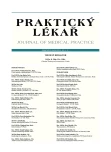Základy kognitivní, afektivní a sociální neurovědy
V. Láska
Authors:
F. Koukolík
Authors‘ workplace:
Primář: MUDr. František Koukolík, DrSc.
; Národní referenční laboratoř prionových chorob
; Fakultní Thomayerova nemocnice s poliklinikou, Praha
; Oddělení patologie a molekulární medicíny
Published in:
Prakt. Lék. 2011; 91(5): 251-257
Category:
Editorial
Overview
Love is a neurobiological, psychological and cultural phenomenon older than civilization. The roots of love are in
– sexual preferences
– mate choice
– sex drive and bond/attachment formation in birds and mammals
There are 237 reasons for human sexual interaction, which have four common factors:
1. physical
2. goal attainment
3. emotions and
4. insecurity
There are differences between female and male strategy in mating and partner preferences. Psychologists describe three dimensions of love:
– intimacy
– passion and
– commitment
Neuronal maps of romantic and maternal love are similar; the difference is activation of periaqueductal grey matter in maternal love.
Key words:
love, sex, male and female strategy, neuronal maps, romantic and maternal love.
Sources
1. Aron, A., Fisher, H., Mashek, D.J. et al. Reward, motivation, and emotion systems associated with early-stage intense romantic love. J. Neurophysiol. 2005, 94, p. 327-337.
2. Bartels, A., Zeki, S. Neural basis of romantic love. NeuroReport 2000, 11, p. 3829-3834.
3. Bartels, A., Zeki, S. The neural correlates of maternal and romantic love. NeuroImage 2004, 21, p. 1155-1166.
4. Beauregard, M., Courtemaneche, J., Paquette, V.S. et al. The neural basis of unconditional love. Psychiatr. Res. 2009, 172, p. 93-98.
5. Brooks, R., Scott, I.M., Maklakov, A.A. et al. National income inequality predicts women´s preference for masculinized faces better than health does. Proc. R. Soc. B. 2011, 278, p. 810-812.
6. Buss, D.M. Sex differences in human mate preferences: evolutionary hypotheses tested in 37 cultures. Behav. Brain Sci. 1989, 12: p. 1-49.
7. Buss, D.M. The evolution of human mating. Acta Psychologica Sinica 2007, 39, p. 502-512.
8. Buss, D.M., Shackleford, T.K. Attractive women want it all: good genes, economic investment, parenting proclivites and emotional commitment. Evolutionary psychology 2008, 6, p. 134-146.
9. Darwin, Ch. The descent of man and selection in relation to sex. New York: Modern Library/Random House 1871/n.d.
10. DeBruine, L.M., Jones, B.C., Little, A.C. et al. Further evidence for regional variation in women´s masculinity preferences. Proc. R. Soc. B. 2010, published online before print December 8, 2010, doi:10.1098/rspb.2010.2200.
11. Data Guru. Types of love [on-line]. Dostupné na www: http://www.dataguru.org/love/fehrtyp.asp.
12. Fisher, H. Why we love: the nature and chemistry of romantic love. New York: Henry Holt, 2004.
13. Fisher, H.E., Aron, A., Brown, L.L. Romantic love: a mammalian brain system for mate choice. Phil. Trans. R. Soc. B. 2006; 361, p. 2173-2186.
14. Gladikas, B.M. Reflections of Eden: My years with the orangutans of Borneo. New York: Little Brown and Co, 1995.
15. Hammock, E.A.D., Young, L.J. Microsatellite instability generates diversity in brain and sociobehavioral traits. Science 2005, 308, p. 1630-1634.
16. Lim, M.M., Murphy, A.Z., Young, L.J. Ventral striopallidal oxytocin and vasopressin V1a receptors in the monogamous prairie vole (Microtus ochrogaster). J. Comp. Neurol. 2004, 468, p. 555-570.
17. Lim, M.M., Young, L.J. Vasopressin-dependent neural circuits underlying pair bond formation in the monogamous prairie vole. Neuroscience 2004, 125, p. 35-45.
18. Meston, C.M., Buss, D.M. Why humans have sex. Arch. Sex. Behav. 2007, 36, p. 477-507.
19. Ortigue, S., Bianchi-Demichelli, F., Patel, N. et al. Neuroimaging of love: fMRI meta-analysis evidence toward new perspectives in sexual medicine. J. Sex. Med. 2010; 7, p. 3541-3552.
20. Sternberg, R.J. A triangular theory of love. Psychol. Rev. 1986, 93, p. 119-135.
21. Trivers, R.L. Parental investment and sexual selection. In: B. Campbell (Ed.). Sexual selection and the descent of man: 1871-1971. Chicago: Aldine 1972.
22. Wallum, H., Westberg, L., Henningson, S. et al. Genetic variation in the vasopressin receptor 1a gene (AVPR1A) associated with pair-bonding behavior in humans. Proc. Natl. Acad. Sci. 2008, 105, p. 14153-14156.
23. Wikipedia. Love [on-line]. Dostupné na www: http://en.wikipedia.org/wiki/Love.
24. Zeki, S., Romaya, J.P. Neural correlates of hate. PLoS ONE 2008, 3(10), e3556. doi:10.1371/journal.pone.0003556
25. Zeki, S. The neurobiology of love. FEBS Lett. 2007, 581, p. 2575-2579.
Labels
General practitioner for children and adolescents General practitioner for adultsArticle was published in
General Practitioner

2011 Issue 5
Most read in this issue
- Chlumský J.: Differential diagnosis of elevated serum troponin in the department of Internal Medicine
- Pohlová L., Kozáková R., Jarošová D.: Burn-out among nurses working in geriatric departments
-
Biologická léčba v onkologii (II)
Monoklonální protilátky, cytokiny - Kučera I., Hlaváč P.: Evaluation of risk factors in the working environment and occupational diseases
